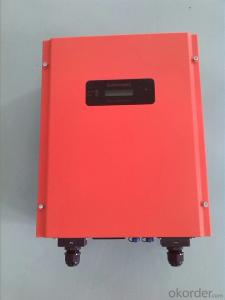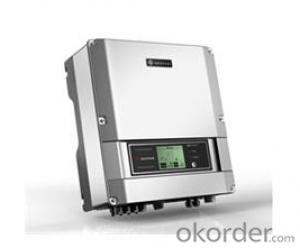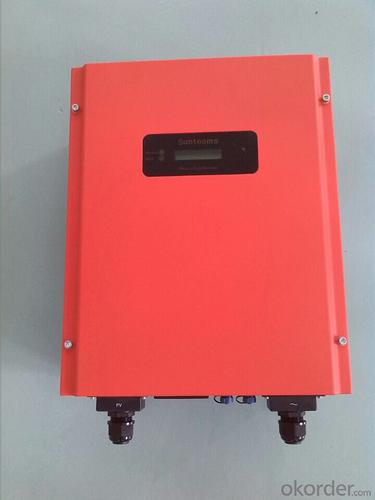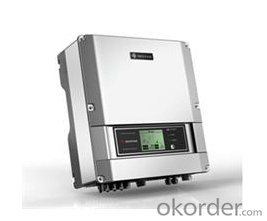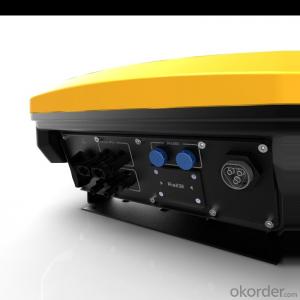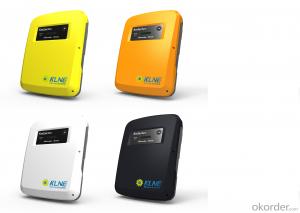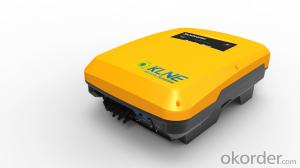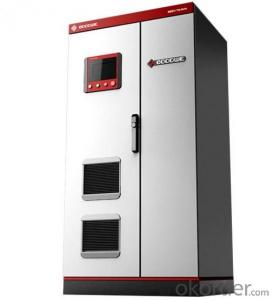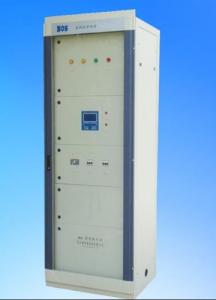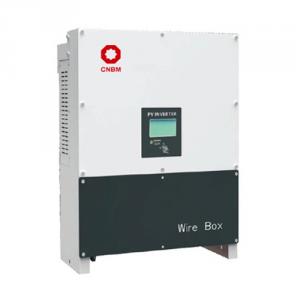Solar Inverter 240v - Solartec Central 500 On-Grid Type
- Loading Port:
- Shanghai
- Payment Terms:
- TT OR LC
- Min Order Qty:
- 10 unit
- Supply Capability:
- 1000 unit/month
OKorder Service Pledge
OKorder Financial Service
You Might Also Like
3. High effiency and low noise
.2. Can used out of doors
The photovoltaic grid-connected inverters in the Solartec Central 250/500 series are applicable to rooftop projects and power plant projects. The nominal output powers of Solartec Central 250 and Solartec Central 500 are 250 kW and 500 kW respectively.
1. Powered by DC current
This series has the Siemens core inverter module, an advanced MPPT algorithm and advanced circuit topology. They have a high conversion efficiency. They have a fast and highly accurate control chip, and have the functions of reactive power compensation, harmonic controlling, overcurrent protection, overvoltage protection, temperature protection, active and passive islanding detection and low-voltage ride through. Additionally, they support optical fiber remote monitoring and have reached European certification standards, including Germany’s.
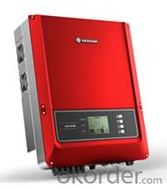
Product Advantages:
1. Powered by DC current
2. Can used out of doors
3. High effiency and low noise
FAQ:
What is your payment terms?
We accept T/T payment, normally we need 20% T/T in advance, 80% payed before shipment.
What is your packing system?
We put the sistem in the wooden box.
Can you do OEM service?
Yes we can, but we need to do it with a certain order quantity.
- Q: What is the difference between a string inverter and a micro inverter?
- A string inverter is a type of solar inverter that is connected to a series of solar panels, converting the DC power produced by the panels into AC power for use in homes or businesses. A micro inverter, on the other hand, is installed on each individual solar panel, converting the DC power into AC power at the panel level. The main difference between the two is that a string inverter handles the entire string of panels, while a micro inverter operates on a per-panel basis. This means that micro inverters offer advantages such as increased energy production, better module-level monitoring, and improved system flexibility, but they can also be more expensive and complex to install compared to string inverters.
- Q: What is the role of a power limiter in a solar inverter system?
- The role of a power limiter in a solar inverter system is to regulate and control the amount of power being fed into the grid. It ensures that the solar system does not exceed the maximum allowable power limit set by the utility company. This helps to maintain a stable and reliable power supply, preventing any potential damage to the grid infrastructure and ensuring compliance with grid regulations.
- Q: What are the key features to consider when purchasing a solar inverter?
- When purchasing a solar inverter, there are several key features to consider. Firstly, the power rating of the inverter should match the capacity of your solar panels to ensure efficient energy conversion. Additionally, the efficiency of the inverter is important as it determines how effectively it converts solar energy into usable electricity. Other crucial features include the type of inverter (string or micro), warranties and certifications, monitoring capabilities, and safety features such as overload protection and anti-islanding protection.
- Q: What is the role of transformerless design in a solar inverter?
- The role of transformerless design in a solar inverter is to eliminate the need for a bulky and heavy transformer, resulting in a smaller, lighter, and more efficient inverter. By removing the transformer, the design reduces energy losses, improves power conversion efficiency, and lowers manufacturing and installation costs. Additionally, transformerless inverters allow for increased flexibility in system design and make it easier to integrate with other renewable energy sources and smart grid technology.
- Q: What is the typical size and weight of a solar inverter?
- The typical size and weight of a solar inverter can vary depending on its power capacity. Generally, residential solar inverters range in size from around 30 x 50 x 20 cm (12 x 20 x 8 inches) to 60 x 60 x 30 cm (24 x 24 x 12 inches) and weigh between 10 kg (22 lbs) to 25 kg (55 lbs). Commercial or utility-scale inverters, on the other hand, can be much larger and heavier, weighing several hundred kilograms (or even tons) and occupying larger spaces.
- Q: What is the warranty period for a solar inverter?
- The warranty period for a solar inverter can vary depending on the brand and model. However, it is common for solar inverters to come with a warranty period of 5 to 10 years.
- Q: How do you choose the right brand of solar inverter?
- Choosing the right brand of solar inverter involves considering factors such as reliability, efficiency, warranty, compatibility with your solar system, and customer reviews. Researching and comparing different brands, their track record, and customer feedback can help in making an informed decision. Additionally, consulting with solar professionals or seeking recommendations from reputable sources can further aid in selecting the most suitable brand for your specific needs and budget.
- Q: Can a solar inverter be used in a solar water pumping system?
- Yes, a solar inverter can be used in a solar water pumping system. In fact, it is an essential component that converts the direct current (DC) generated by the solar panels into alternating current (AC) required to power the water pump. The inverter ensures compatibility between the solar panels and the pump, allowing for efficient and reliable operation of the system.
- Q: Are there any limitations on the angle of the solar panels when using a solar inverter?
- Solar panels must adhere to certain limitations in terms of their angle when using a solar inverter. The efficiency and overall performance of solar panels can be influenced by the angle at which they are installed. Ideally, solar panels should be positioned at an angle that allows them to receive the maximum amount of sunlight throughout the day. Typically, solar panels are designed to function optimally when installed at an angle that matches the latitude of the location. This angle enables the panels to capture the most sunlight during peak hours. However, this is not an absolute rule, as variations are feasible depending on specific location and climate conditions. If solar panels are installed at angles that are excessively steep or shallow, it can result in decreased energy production. Steep angles may cause sunlight to be lost during certain times of the day, while shallow angles may not allow for optimal sunlight absorption. Moreover, extreme angles can increase the risk of damage from wind or other weather conditions. It is worth noting that modern solar inverters often incorporate advanced tracking and monitoring technologies, which can adapt to different panel angles and orientations. These features can optimize energy production by adjusting the inverter settings based on the real-time performance of the panels. Ultimately, while there are limitations concerning the angle of solar panels, it is crucial to ensure that they are installed in a manner that maximizes their exposure to sunlight throughout the day, in order to achieve the highest possible energy production.
- Q: How does a solar inverter provide ground fault protection?
- A solar inverter provides ground fault protection by continuously monitoring the current flow between the solar panels and the electrical grid. If any ground fault or leakage current is detected, the inverter immediately interrupts the circuit to prevent potential electrical shock hazards and damage to the system.
Send your message to us
Solar Inverter 240v - Solartec Central 500 On-Grid Type
- Loading Port:
- Shanghai
- Payment Terms:
- TT OR LC
- Min Order Qty:
- 10 unit
- Supply Capability:
- 1000 unit/month
OKorder Service Pledge
OKorder Financial Service
Similar products
Hot products
Hot Searches
Related keywords
